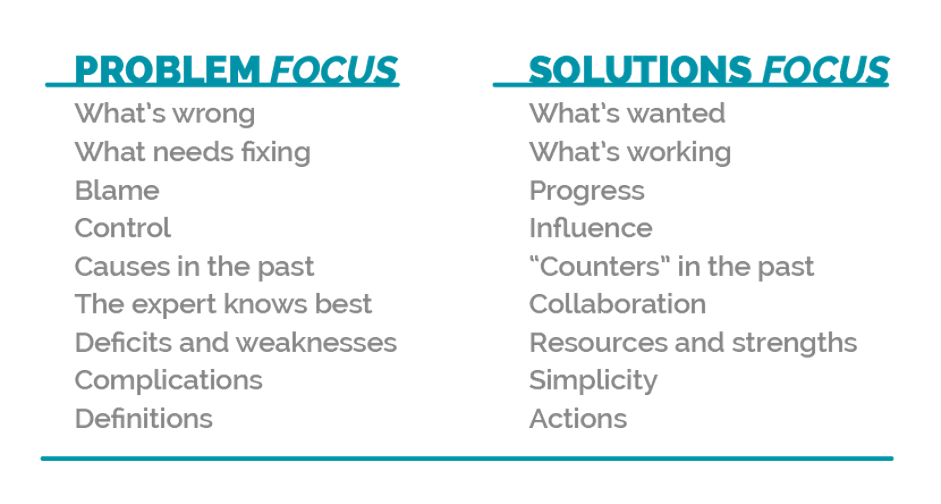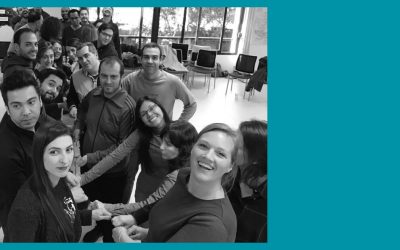Look ahead! Solution-Focused Leadership at a Glance
With solution-focused leadership, you have the tools to get in touch with your strongest visions, connect with your team and design methods to create results. These problem-solving techniques are geared toward building a constructive environment.
In this approach, as a leader, you get to feel accomplished as you see results and great teamwork at play. As employees, your team members feel motivated and appreciated. And, as a whole, the organization can move forward towards growing and making their larger vision come to life.
To foster this positive change, you can start by taking a look at the ideas of Paul Z. Jackson and Mark McKergow in their book The Solutions Focus.
The mantra here is: Don’t focus on the problems, focus on what is possible.
To shift from Problem Focus to Solution Focus, consider these differences:

(image from The Solution Focus, Paul Z. Jackson and Mark McKergow)
When deciding on which changes to make in the processes and routines of your team, remember:
- If it isn’t broken, don’t fix it.
- Find what works, and do more of it.
- If it isn’t working, do something else.
“What is so radical about it? Focusing on solutions (that is, defining and acting on what is wanted and what is better) rejects conventional approaches that share the widespread assumption that focusing on problems (by analyzing, reacting to and talking about them) is the best way to solve them”
Paul Z. Jackson and Mark McKergo
What is solution-focused leadership in a nutshell?
The essence of solution-focused leadership, as Sarah McVanel explains, is:
- To work with the person rather than the problem
- To look for resources rather than deficits
- To explore possible and preferred futures
- To explore what is already contributing to those possible futures
- To treat people as the experts in all parts of their lives
What can you do as a solution-focused leader?
An easy-to-implement action for the leader is just to pay attention to the individuals and the dynamics at play. Look around, observe and listen closely.
Can you answer the following questions?
- What are they positively talking about? (this is what is working at the dynamics)
- What are they talking about that needs acknowledging? (what are their underlying needs?)
- Do they need to feel validated? Do they need to feel appreciated?
To learn more about leadership skills, approaches and methods, check our previous articles:
- Discover yourself! Leadership starts with who you are
- Take a Spin! When Leadership goes 360
- Connecting People: Understanding team dynamics for performance
- Keys to Employee Engagement
For exercises to practice with your team, download our worksheet Create Cohesive Teams.
If you tend to focus on problems, rather than solutions, download our worksheet Change Your Mindset.
We encourage you to understand that leadership is not about knowing but experiencing and learning about your unique leadership style that fosters your own strengths and grows your team’s abilities to excel at their contribution at work. Therefore, we are writing about a few leadership related theories, approaches, and techniques that may be useful to you.
Our leadership topics are a free selection by us of authors and streams of theory, without having any commercial or affiliate biases. Hopefully, our articles will inspire you to check out new stuff or re-visit and value some of the interventions you may have already implemented.
If you are looking for workshops and training to help your team succeed in working together, don’t hesitate to get in touch. Book a free call with us, let’s talk about how to take your team to the next level.

MAIKE STOLTE
Executive Coach. Consultant. Trainer. Facilitator.
Categories
Contact us

Burnout. COVID. New Normal: How to get yourself back into balance & recover!
By now, most of us share a similar feeling: we feel drained. For months now, we have been bravely facing the Covid-19 pandemic. I think it’s fair to say that it has taken its toll on us. No matter your context, you may have been dealing with the stress of the...
Relational leadership: Influence is trusting and being trusted
We are our relationships. When we foster positive relationships, we create positive environments, develop positive projects and bring positive change to the world. This power of relationships is the base of relational leadership, focused on the leader’s ability to...
Insights From Natural Leaders: With Yasmine Khater
We can always find inspiring natural leaders close to us! In this series of interviews, I’m talking to people who have touched my soul: small business owners, neighbors, friends & colleagues. Those who inspire me to spread the wisdom & insights of our common...





0 Comments